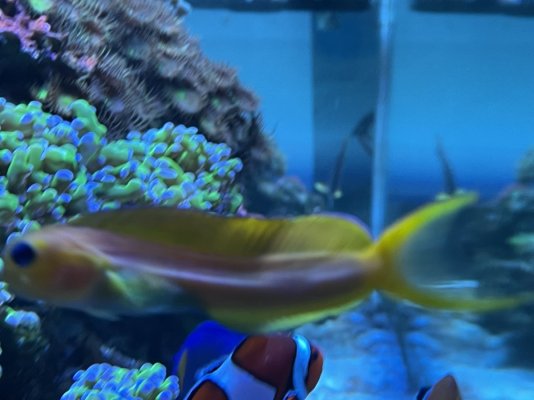Skinny blennies:
Midas blennies are much more difficult to maintain than their common presence in the pet trade would have you believe. They are very prone to starvation. It is unknown if this is due to not feeding them often enough, not feeding enough, feeding the wrong foods, or if internal parasites compete with the blenny for food energy. This species lacks a swim bladder, so they must expend quite a bit of energy just to maintain their location on the water column. This must be offset by a huge amount of calories. Aquarists often miss the fact that their Midas blennies are becoming gradually thinner – as the fish still feeds ravenously, and the progression of the problem is fairly slow. At some point, the fish begins to utilize their liver for food energy. Once this point is reached, the liver damage is irreversible and death is inevitable. A similar issue is also seen with algae blennies, Salarias fasciatus. In these cases, the problem is often tied in to the fish eating all available algae in an aquarium and subsequently starving.
A means to resolve this problem is unclear, since the actual cause is unknown. The best option may be to feed these fish to satiation four times per day, and offering less brine shrimp, and more high fat mysid shrimp. If the blenny takes food in but spits it back out, try dicing the food into smaller pieces. Clearing these fish of possible internal parasites is not an easy task. Praziquantel is often suggested as a cure, but in reality, this drug is only effective against monogeneans (external flukes) and cestodes (tapeworms). If internal parasites are indeed the issue, they may well not be of these two groups. Still, it may be a good idea to dose the tank with praziquantel at 2 mg/l twice, 10 days apart, just in case that will clear the issue. Medicated foods may also be of benefit, but only if properly dosed as mentioned elsewhere. Soaking the food in medication is a useless endeavor, as the medication dose is completely unknown, and then, the amount of medications that washes off the food makes the issue even worse. Medications must be bound into the food items and dosed at a proper level.
Midas blennies are much more difficult to maintain than their common presence in the pet trade would have you believe. They are very prone to starvation. It is unknown if this is due to not feeding them often enough, not feeding enough, feeding the wrong foods, or if internal parasites compete with the blenny for food energy. This species lacks a swim bladder, so they must expend quite a bit of energy just to maintain their location on the water column. This must be offset by a huge amount of calories. Aquarists often miss the fact that their Midas blennies are becoming gradually thinner – as the fish still feeds ravenously, and the progression of the problem is fairly slow. At some point, the fish begins to utilize their liver for food energy. Once this point is reached, the liver damage is irreversible and death is inevitable. A similar issue is also seen with algae blennies, Salarias fasciatus. In these cases, the problem is often tied in to the fish eating all available algae in an aquarium and subsequently starving.
A means to resolve this problem is unclear, since the actual cause is unknown. The best option may be to feed these fish to satiation four times per day, and offering less brine shrimp, and more high fat mysid shrimp. If the blenny takes food in but spits it back out, try dicing the food into smaller pieces. Clearing these fish of possible internal parasites is not an easy task. Praziquantel is often suggested as a cure, but in reality, this drug is only effective against monogeneans (external flukes) and cestodes (tapeworms). If internal parasites are indeed the issue, they may well not be of these two groups. Still, it may be a good idea to dose the tank with praziquantel at 2 mg/l twice, 10 days apart, just in case that will clear the issue. Medicated foods may also be of benefit, but only if properly dosed as mentioned elsewhere. Soaking the food in medication is a useless endeavor, as the medication dose is completely unknown, and then, the amount of medications that washes off the food makes the issue even worse. Medications must be bound into the food items and dosed at a proper level.





















